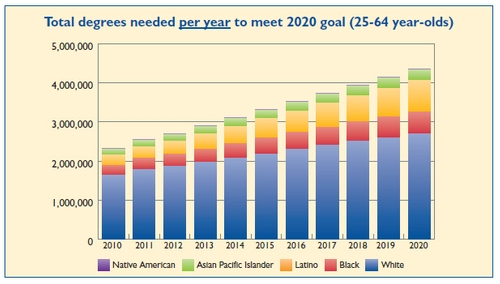America cannot become the world leader in college degrees by 2020, or have the globally competitive workforce of the future, without a tactical plan for increasing Latino college completion, this according to the report, “Roadmap for Ensuring America's Future.”

Latino educational attainment is currently lower than that of other groups (only 19 percent of Latino adults have earned an associate or higher degree); and, many economically competitive jobs in the U.S. will soon require education beyond a high school degree. Between 2005 and 2022, the number of Hispanic public high school graduates in the United States is projected to increase by 88 percent, while the number of white high school graduates is expected to decline by 15 percent. And in 2008, only 19 percent of Hispanics ages 25 years and up had earned a postsecondary degree, compared with 29 percent of black young adults and 39 percent of white ones.
To increase Latino degree attainment, the report recommends a range of policy recommendations for communities, colleges, and state and federal officials. Communities especially need to develop partnerships between school districts and higher education institutions to align high school and college curriculums, courses, and assessments to smooth and propel students’ transitions to college.
And it recommends that higher education institutions search for ways to be more flexible in accommodating working students. Latino undergraduates had the highest average work-study aid award of any racial or ethnic group in 2007-8, according to the report. It offers a policy example from the Puerto Rico-based Universidad del Sagrado Corazón (University of the Sacred Heart), which offers main courses online as a backup system for students in good academic standing with unexpected work schedule changes.

The report also includes a profile of the Latino student demographic. The vast majority of Latinos are non-immigrants (in 2007, close to 90 percent of K-12 Latino students were U.S.-born); the majority are high school graduates (studies suggest between 21 and 40 percent of Latinos drop out), and most speak English (in 2007-8, more than 80 percent of Latino school-age children spoke English with no difficulty).
Other findings: 37 percent of Latino high school graduates aged 18 to 24 attended college, compared to 49 percent of white high school graduates. And in 2007, about 50 percent of Latinos enrolled in college were the first in their families to go to college, compared with 28 percent of white students.
Source: Excelencia In Education, “’Roadmap' for Latino College Success,” March 10, 2011.